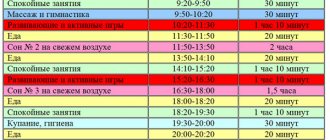Many parents believe that from the age of 3 a child can eat the same dishes as adults.
Many parents believe that from the age of 3 a child can eat the same dishes as adults. This is not entirely true.
Of course, a three-year-old baby can consume much more foods than in the first years of life.
However, for healthy development and growth, a child needs nutritious nutrition with a balanced amount of proteins, fats, carbohydrates, microelements and vitamins.
The child's body is still growing very intensively, so it needs a constant supply of strength in the form of energy obtained from food. So, what does a child need?
How does a mother know if her baby is eating enough adult food?
All pediatricians will say: “The child will never go hungry!” A huge number of healthy children will eat the right amount of the foods they need. Parents need to resist the urge to offer “just one more bite” when the child indicates they are finished. After all, you don’t want to accidentally disrupt the child’s developing ability to self-regulate his or her feeding by continuing to try to feed or nurse the child. It is important for parents to pay attention to their baby's signals, as the baby's feeding patterns will change daily and may be affected by activities around him. Offering a good balanced diet can ensure that the child eats the right amount of nutrients.
Rules and regulations
Pediatricians advise monitoring the caloric content and balance of baby food and not overloading the growing body.
The energy value of breakfast should be about 25% of the daily caloric intake, while lunch should be about 40%. A hearty midday meal and a short rest are followed by an afternoon snack, which includes light dishes, the total calorie content of which does not exceed 10%. The remaining 25% comes from the last meal - dinner.
When drawing up a weekly balanced menu for a 5-year-old child, you need to take into account the nature of nutrition in a preschool institution (preschool institution). The kindergarten takes a strict approach to diet planning so that children gain weight within normal limits. But it wouldn’t hurt for caring parents to clarify the menu in order to make the children’s table more varied and rich in nutrients.
If the kindergarten menu seems too monotonous to you, you should not feed your child at home the same “boring” food, although it is healthy for him. Show some imagination.
4 months:
Infants under 4 months of age should not receive solid baby foods. Infants should be able to sit up and feed themselves from a spoon before complementary feeding is introduced.
Why can’t a mother introduce complementary foods to a child under 4 months of age? Introducing solids too early means that the baby receives less breast milk during infancy and this reduces the opportunity to receive optimal benefits in the form of protection against infection.
What to feed your baby:
Formula milk or breast milk every 1-3 hours, formula milk 500-1200 grams per day
Nutrition for a child aged 1.5 to 3 years and menu
Nutrition for a child aged 1.5 to 3 years
The diet of a child from 1.5 to 3 years old is increasingly closer to what is usually eaten at the family table. At this age, one of the most important tasks is to teach the baby to chew. Larisa Titova Pediatrician, nutritionist, employee of the Department of Nutrition of Children and Adolescents of the Russian Medical Academy of Postgraduate Education By the age of two, children have up to 20 milk teeth, which allows them to chew food well. At the same time, the production of digestive juices increases and food is easier to digest, which is why it is so important to teach the child to eat properly in a timely manner. To do this, it is necessary to replace liquid and semi-liquid foods with denser ones: gradually introduce boiled porridges, vegetable and cereal casseroles, and stewed vegetables. If a baby at this age is not taught to eat dense foods that require chewing, then in the future he will be reluctant to accept or even refuse such necessary dishes as pieces of meat, fruits, and vegetables. A child aged 1.5 to 3 years should have four meals a day - breakfast, lunch, afternoon snack and dinner. Moreover, at lunch he should receive approximately 40–50% of the total nutritional value of the diet, and the remaining 50–60% is distributed for breakfast, afternoon snack and dinner. The energy value of products per day is 1400–1500 kcal. A child needs to receive 50–60 grams of protein per day, 70–75% of which should be of animal origin; fats – 50–60 grams, including about 10 grams of vegetable origin; carbohydrates – 220 grams. As at the very beginning of the second year of life, a child 1.5–3 years old needs to consume a sufficient amount of fermented milk products daily, up to 550–600 grams (this number also includes the amount that goes into preparing various dishes). Fresh cottage cheese, various types of cottage cheese products and cheeses for children, mild varieties of cheese, sour cream and cream for dressing soups and salads should be present in the child’s diet. Children of this age require on average 25–50 g of cottage cheese per day (fat content 5–11%), 5–10 g of cream or sour cream (10–20%), 5 g of cheese, 500–550 ml of milk and kefir (3.2 -4%). Cottage cheese, sour cream, cream, cheese can be used after 1-2 days in larger quantities, for example, for making dumplings, cheesecakes, casseroles. Milk and fermented milk drinks should be included in the diet daily. With age, the amount of meat in a child’s diet gradually increases - from 100 g at 1.5 years to 120 g by 3 years. Usually they use beef, veal, lean pork, rabbit, lamb, and horse meat. Offal products are useful in baby food (they are rich in protein and fat-soluble vitamins, especially vitamin A, have a more delicate structure than meat, and therefore are more easily and quickly digested in the gastrointestinal tract) - liver, tongue, heart. Meat can be prepared in the form of steamed, oven cutlets, stews, or fried minced meat. From sausages, not often and in limited quantities, to expand the taste perception, you can give your baby milk sausages and some types of boiled sausage (diet, milk, doctor's). A chicken egg, which is one of the main suppliers of protein, should be given, on average, 1/2 a day, or 1 egg every other day and only hard-boiled or in the form of an omelet, and also used for making casseroles and cutlets. If there are no medical contraindications, the child’s menu should include dishes from sea and river fish, with the exception of fatty and delicacy varieties (sturgeon, salmon, salmon, halibut) up to 30–40 g/day. Children can be offered boiled or fried fish, freed from bones, fish cutlets, and meatballs. Smoked and canned fish (with the exception of specialized canned food for children), as well as caviar, which is a very fatty and highly allergenic product, are not recommended. Due to the fact that fruits and vegetables contain a large amount of ballast substances, including dietary fiber, sufficient consumption of them in the daily diet can serve as a preventive measure for constipation. An important property of vegetables and fruits is their ability to enhance the secretion of digestive juices, which increase appetite. Children from 1.5 to 3 years old are recommended to consume potatoes daily in quantities of up to 100–120 g/day. (including for preparing first courses). If for some reason potatoes are not used in the diet, then they can be replaced in the same volume with other vegetables. And also 150–200 g of various vegetables for making soups, salads, and side dishes. Especially useful: carrots, cabbage, zucchini, pumpkin, beets, tomatoes. Unlike the diet of young children, the food of a child over 1.5 years old must constantly include garden greens: parsley, spinach, lettuce, green onions, garlic in small quantities for seasoning soups, salads and main courses. At this age, the vegetable diet is expanded due to the introduction of radishes, radishes, turnips and legumes such as peas, beans, and beans. Vegetable purees are replaced with finely chopped salads, stewed and boiled vegetables, cut into small pieces. Fruits are an obligatory component of a child’s daily diet – 100–200 g/day. and berries 10–20 g/day. Kids enjoy eating apples, pears, plums, bananas, and cherries (the seeds must be removed from them first). Considering the high likelihood of an allergic reaction to citrus and exotic fruits, their introduction into the diet should be extremely careful. Among the berries, black currants, gooseberries, lingonberries, cranberries, chokeberries, and sea buckthorn are especially useful. Some fruits and berries have a fixing effect because they contain tannins. These include blueberries, pears, and black currants. This is important to consider if your child suffers from constipation. Kiwi has a pronounced laxative effect, but other fruits and berries eaten in large quantities can have the same effect. Various fruit, berry and vegetable juices are useful for children of all ages, but if clarified juices are recommended for children under one year old, then after 1.5 years you can offer the baby juices with pulp up to 100-150 ml per day after meals. Any new product that you are going to include in your child’s menu should be given in small quantities (1-2 teaspoons) in the first half of the day in order to be able to monitor the body’s reaction to the tolerance of the “new product”. If signs of an allergy appear, use of this product should be discontinued. Various cereals are used in the diet of children over one and a half years old. Oatmeal and buckwheat, rich in mineral salts and vitamins, and complete protein, are especially useful. It is useful to include cereals such as barley, millet, and pearl barley in your diet. Children of this age can already eat noodles, vermicelli in the form of side dishes or milk soups, but they should not get carried away with these products, as they are rich in carbohydrates. On average, children over 1.5 years old should be given no more than 15–20 g of cereal and 50 g of pasta per day. Sugar is also included in children's diets. It improves the taste of dishes, but its excess is harmful to the child’s health, as it reduces appetite, can affect metabolism and lead to excessive weight gain. A child aged 1.5 to 3 years can consume up to 30–40 g of sugar per day. This amount includes easily digestible carbohydrates - glucose contained in juices, drinks, and sweets. Foods containing carbohydrates - bread, pasta, potatoes, cereals, in the quantities recommended above, will not provide the child with the amount of energy required for his age. The physiological characteristics of the gastrointestinal tract and enzyme systems of the child’s body do not allow increasing the volume of a single meal, which means that calorie content can only be replenished with easily digestible carbohydrates. Their use in the diet of a healthy child is necessary, since glucose is an energy substrate for the cells of the brain, liver, and kidneys. But everything should be within reasonable limits. Sweets that you can pamper your child with are marshmallows, marmalade, fruit caramel, jam, marshmallows. Chocolate and chocolate candies should not be offered to your baby, as they increase the excitability of the nervous system and can cause allergic reactions. Approximate one-day menu for children from 1.5–3 years Breakfast Buckwheat liquid milk porridge 1.5–2 years: 120 ml 2–3 years: 150 ml Steam omelette 1.5–2 years: 50 g 2–3 years: 50 –60 g Fruit juice 1.5–2 years: 100 ml 2–3 years: 150 ml Lunch Beetroot salad, seasoned with sour cream 1.5–2 years: 30 g 2–3 years: 50 g Prefabricated vegetarian soup, fine chopped vegetables 1.5–2 years: 50–100 ml 2–3 years: 100–150 ml Beef puree 1.5–2 years: 50 g 2–3 years: 70g Boiled vermicelli with butter 1.5–2 years: 50 g 2–3 years: 50-70 g Dried fruit compote 1.5–2 years: 70 ml 2–3 years: 100 ml Afternoon snack Milk 1.5–2 years: 200 ml 2–3 years: 150 ml Cookies (biscuits) 1.5–2 years: 15 g 2–3 years: 15 g Fruits 1.5–2 years: 100 g 2–3 years: 100 g Dinner Vegetable salad seasoned with vegetable oil (stewed vegetables) 1 ,5–2 years: 100 g 2–3 years: 50–70g Fish balls 1.5–2 years: 50 g 2–3 years: 60 g Mashed potatoes 1.5–2 years: 60-80 g 2–3 years: 100 g Kefir 1.5–2 years: 150 ml 2–3 years: 200 ml
4-6 months:
If baby can sit up on his own and seems hungry after primary breastfeeding, baby is ready to introduce solid foods! The child should be able to hold his head up well, close his mouth with a spoon, and move food to the back of his mouth. All signs of readiness for complementary feeding can be read here.
What to feed your baby:
Formula or breast milk
1-3 tablespoons of food for 1 or 2 dishes
8-10 months:
Many children will eat 3 meals a day at this stage; including cereals, fruits, vegetarian dishes, bread and meat, maybe eggs.
It is important for parents to pay attention to the baby's cues, as the baby's feeding patterns will change daily and may be affected by the activities going on around him. The child will eat only the right amount of food for himself.
What to feed your baby:
Formula or breast milk
Complementary feeding 3 times a day
Pleasant exceptions
Children as young as 5 years old can eat sweets. But mothers will still have to monitor the amount of all kinds of goodies and the child’s body’s reaction to them. Excess sweets lead to overweight of the child and, as a result, slow development.
Once a week you can treat your growing body with something special. For example, many children like homemade pizza made with sausage, vegetables and herbs. Such a tasty surprise will not spoil the diet, and will add the necessary variety to the menu.
10-12 months:
Many children will feed 3 times a day at this stage; including cereals, fruits, vegetarian dishes, bread, meat, fish, eggs.
It is important for parents to pay attention to the baby's cues, as the baby's feeding patterns will change daily and may be affected by the activities going on around him. The child will eat only the right amount of food for himself.
What to feed your baby:
Formula or breast milk
Complementary feeding 3 times a day plus 2 additional snacks
Food basket
- The daily menu of a child developing every day should include meat, vegetables and fruits.
- Eggs and fish are cooked 2 times a week.
- Butter is permanently included in the children's menu.
- It is better to alternate vegetable oils to get maximum benefits and protect your baby from possible allergies. The most popular mommy's helpers: olive, corn, soybean, sunflower and flaxseed oil. They allow your child to receive much-needed vitamin E and polyunsaturated fatty acids in the required amount.
Vegetables and fruits
Some parents make a big mistake when organizing a balanced diet for their children - they do not give enough fruits and vegetables, especially raw ones. Because of this, the growing body receives little plant proteins, natural enzymes, pectins, essential oils, phytoncides and other substances that prevent the proliferation of putrefactive bacteria and fungi in the digestive tract.
If there is a lack of vegetables in a child's diet, constipation often occurs. That's why it's so important to include salads made from raw vegetables with the addition of green onions and other fresh herbs.
Nutritionists advise serving vegetables and fruits for breakfast and dinner. This could be a vegetable stew made from stewed ingredients or a salad made from fresh ingredients, a cottage cheese casserole with fruits, berries, grated zucchini or potatoes.
Raw, uncooked plant foods are needed to strengthen the immune system and improve digestion. Beetroot salad, for example, is an excellent preventative against constipation.
But you should avoid using garlic and bitter varieties of onions, so as not to discourage your child’s love for vegetables.
Signs that your baby is full
- Closing the mouth when the spoon approaches it
- Spitting out food when feeding
- Turning your head to the side when the spoon approaches
A healthy, well-fed baby should wet diapers regularly and have bowel movements once or twice a day.
When visiting a doctor, you need to make sure that the child is healthy so that the child's height and weight are properly monitored according to the schedule.
If you have any doubts about feeding your baby, you should consult your pediatrician about foods and the size of solid foods. The doctor should be able to help establish feedings and also help allay concerns.
It is important to remember to consult with your pediatrician about introducing solid foods to your baby and specifically discuss any foods that may pose an allergy risk to your baby.
No two children are alike and will eat the same foods. And the amount of food for each child is individual!
To calculate your daily milk intake you can use the following:
| Age | Weight | Calculation of daily milk volume | |
| 1 | 1 month | 3500 | 3500÷5=700 |
| 2 | 5 months | 6200 | 6200÷7=885 |
Forming a diet
An important point in planning meals for preschoolers 5 years old is the volume of dishes served. A five-year-old child should receive approximately 1800 g of healthy foods per day. Even if your fidget never refuses to eat, it is better to adhere to this norm in order to avoid problems such as weight problems and disruptions in the gastrointestinal tract.
The total volume of products must be divided into approximately equal portions. In other words, at one time the child should eat a portion weighing 450-550 g.
Thanks to a large selection of recipes, products and methods of preparing them, the diet of a five-year-old child can be made equally varied and balanced. At this age, babies can be offered almost any food, with the exception of especially spicy or bitter ones. It is allowed to include canned food in a preschooler's menu, but only occasionally and in small quantities.
If canned foods are a must, choose ones that do not contain bisphenol-A (BFA). Information about its presence or absence must be indicated on the label.
You should be careful when including fatty foods in your child’s diet, as they require more time and energy to digest. This is why high-calorie, high-fat foods should be served to children only in the first half of the day.
Intervals between meals
The process of digesting food in a five-year-old child is approximately 3-3.5 hours, which means that the intervals between meals should approximately correspond to the specified time range.
Ideal meal schedule for a 5-year-old fidgety:
- breakfast at 8 a.m.;
- lunch after 12 noon;
- afternoon tea at approximately 15:30;
- dinner no later than 19 pm.
In between feedings, it is necessary to ensure that the child does not snack. This is especially true for sweets.
It is important to maintain a healthy ratio of fats, proteins and carbohydrates in the proportion: 1:1:4.
The daily calorie requirement for normal growth and development of a five-year-old child is approximately 1970 kcal.
If for a 3-4 year old child the basis of the diet was liquid porridge, then by the age of 5 they are replaced by crumbly porridge, and cocoa and tea with milk appear on the menu as drinks.
Some parents, unknowingly, prematurely begin to give their child another invigorating drink. Don't think your child can drink coffee at this age. This is not a very smart solution.
Watch your baby's cues when feeding him solid foods
All of the baby's signals during feeding indicate that the baby is eating the appropriate amount of food for him.
There is no exact rule or guideline for how much a child should eat during the day. Simply because every child is different. Babies will eat food and drink as much formula or breast milk as they need.
For example, one 7-month-old baby eats 2 whole jars of baby food in one day, while another 7-month-old baby barely manages to eat one. Also, one child may eat every 2 hours at 7 months, and another every 3-4 hours. Again, each child has different nutritional and milk needs and these needs are selected individually.
We are not afraid and add me to Odnoklassniki and Instagram!
Did you like the article? Subscribe to site updates
"Encyclopedia of Baby Food"!
Don't forget to bookmark us! (CTRL+SHiFT+D) Subscribe to the site, comment, share on social networks.
On our website Encyclopedia Baby Food there is useful information on the nutrition of your children, which is useful for everyone, and we update the Encyclopedia Baby Food website constantly and try to search and write only excellent, verified and necessary information for you and your children.
Disclaimer #1: It is necessary to understand that the author of the articles on the Encyclopedia Baby Food website is not a medical professional, “I am not a doctor.” The information I share is based on my own experience. My goal is not to teach you how to eat or feed your child, but to tell you about what we did, what new things I learned or read. This allows you to expand your knowledge about baby food, allows you to see the whole process so that you can decide whether you like it or whether it’s worth doing the same.
Disclaimer #2 : However, the above does not replace visiting your pediatrician. Before you start complementary feeding, you should seek his professional opinion on the best way to introduce new foods to your baby. Please also note that you need to look at the original date of published articles, as some “best practices” may have changed. Always consult your child's pediatrician about complementary feeding and his or her health.
Disclaimer #3: Keep in mind that every family is unique, and every situation is completely unique. There are no universal solutions. Only you can find what works best for you. Certain goals require certain sacrifices and priorities—not everyone wants to make those choices, and that's GREAT! Just know what you want to achieve and be ready to get to work doing your best!
Disclaimer No. 4: The Encyclopedia Baby Food website uses photos from books on baby food with attribution for a more complete understanding of the information (Article 1274, paragraph 1, part four of the Civil Code of the Russian Federation). Literature on baby nutrition was found freely available on the Internet.
Apricot puree with chicken Banana-apple puree Banana puree Borscht Broth with peas and rice Kohlrabi sandwich Quick dessert made from ready-made dough Zucchini jam with strawberries Buckwheat with green peas Buckwheat porridge Buckwheat porridge with apricots Buckwheat porridge with banana Buckwheat pilaf Children's sausage Children's milk porridge with banana Children's vinaigrette Children's ketchup Children's cucumber salad Children's Olivier salad Children's porridge cookies Children's puree of strawberries, banana, yellow cherries, matsoni and cookies with cereals Children's puree with cottage cheese and fruit Homemade yeast bread with flaxseed flour Homemade pizza Breakfast on the street Snack from kohlrabi Baking cauliflower Baked carrots Baked carrots and cherries with millet Winter salad with Jerusalem artichoke Cabbage with white beans Cabbage salad as in the cafeteria Mashed potatoes Quinoa and pumpkin porridge Porridge Quinoa porridge for breakfast Quinoa and apple Strawberry puree Strawberry puree with banana Strawberry compote Compote from wild apples and raspberries Compote of dried fruits steamed in a thermos" for a child over 8 months Corn porridge Corn porridge with pear Corn porridge with pumpkin Corn porridge with pumpkin and carrots Corn porridge with apple and carrots Chicken cutlets with carrots Chicken with carrots, sweet peppers and potatoes Navy-style pasta Pasta with orange sauce Milk noodle soup Carrot and potato puree Carrot and rice casserole Carrots with chicken Fly agarics made from eggs and tomatoes Vegetable puree from cauliflower and carrots Vegetable soup with corn semolina Vegetable soup with cheese and corn semolina Vegetable cream soup with bell pepper Oatmeal Pancakes with hot kefir Omelette in a bag Omelette with broccoli and cauliflower Omelette pancake Peach puree Baked apples 7 months + Zucchini and carrot pie Zucchini pie Rice and zucchini pie White cabbage pizza Rabbit pilaf Chicken pilaf with green peas and corn Banana and cherry puree Banana, cottage cheese and porridge puree 4 grains Broccoli (cauliflower) puree Broccoli, zucchini and cauliflower puree Blueberry puree Pear puree Pear and banana puree pear and banana, baking Pear and pumpkin puree 7 months + Pear, pumpkin and peach puree Pear, apple, plum and prune puree Turkey puree Zucchini puree Zucchini and broccoli puree Zucchini, carrot and potato puree Quinoa puree and banana Quinoa and carrot puree Quinoa, banana and carrot puree Quinoa, zucchini and carrot puree Quinoa, peach and raspberry puree Quinoa, cauliflower, apple, pea and mint puree Quinoa, apple, pear and raisin puree quinoa, apple, carrot puree rabbit, broccoli and cauliflower puree chicken, carrot, potato, apple and pea puree raspberry, cherry and banana puree carrot puree carrot and apple puree carrot, potato, broccoli puree with cheese puree from carrots, potatoes, apples and quinoa Carrot, pumpkin, apple and prune puree Carrot, apple and potato puree Turnip and carrot puree Plum puree Cottage cheese, strawberry and banana puree Pumpkin puree Pumpkin and banana puree Pumpkin puree and zucchini Pumpkin and apple puree Pumpkin, apple and banana puree Cauliflower and broccoli puree Cauliflower and potato puree Cauliflower and rice puree Cauliflower and apple puree Cauliflower, green pea and zucchini puree Cauliflower puree cabbage, turkey and potatoes pureed cauliflower, potatoes and zucchini pureed cauliflower, carrots and broccoli pureed cauliflower, carrots, cheese and rice pureed cauliflower, apples and zucchini pureed zucchini pureed zucchini and potatoes pureed zucchini , carrots and apples Cherry puree Blueberry puree Prune puree Apple, pumpkin, carrot puree and a little curry Apple and pear puree Apple and strawberry puree Apple, strawberry and cherry puree Apple, peach and banana puree Carrot puree with pumpkin Cottage cheese and banana puree Turkey, potato and carrot ragout Zucchini, carrot and broccoli ragout Fish, potato, carrot and broccoli ragout Rice porridge Whole grain rice porridge Rice porridge with carrots Rice porridge with pumpkin Rice porridge with apples Rice porridge with apple and pear Rice porridge with apple and pumpkin Fish cutlets with vegetables Semi-finished fish Fish balls with ketchup Fish soup for children Fish soup with salmon and celery Carrot and kohlrabi salad Chickpea salad The laziest soup Creamy kohlrabi puree soup Smoothie with oatmeal One Pot Sauce Pea and Bacon Soup Roasted Vegetable Soup Kohlrabi Soup Salmon Soup Cauliflower Soup Potato and Turnip Soup Meatball Soup for the Picky Eater Cream of Rabbit, Pumpkin, Potato, Broccoli and Cauliflower Soup Cream of Soup beets Pumpkin puree soup with mushrooms Broccoli and celery puree soup Pork soup/stew with potatoes and carrots Cheese pasties Pumpkin cheese sauce (Annabelle Carmel's recipe) Pumpkin-apple puree Pumpkin-apple juice Pumpkin cake Pumpkin puree soup Fruit salad Fruit salad with mango Bread lavash Cauliflower with cheese Linden and thyme tea Experimental puree soup with noodles and lentils Applesauce Apple juice
Recommendations from experts
Creating the correct daily menu for a 5-year-old child is not so easy. It is necessary to take into account the recommendations of specialists.
- Let's start with cereals - there are many of them and they are all very healthy, but the daily menu should not include more than one cereal dish.
- You should not combine dishes that contain a lot of protein with fats: in this case, the food will linger in the stomach for a long time, and much more digestive juices will be required to digest it. This can lead to unnecessary weight gain. Protein foods are best consumed in the first half of the day.
- For lunch, it is advisable to include soup in your child’s diet: meat and vegetable broths have a positive effect on the functioning of the digestive system and prevent constipation.
- For dinner you need to give food that is easily and quickly digested, because at night the body does not waste energy. Vegetable and dairy foods are suitable for this role.
- But not all products, including even the healthiest ones, should be present on a daily basis. For example, fish should be offered only 2 times a week.
- Of the cereals, the most valuable for the normal growth and development of a child are buckwheat and oatmeal. They are distinguished by the maximum content of proteins and mineral compounds.
It is advisable to prepare a children's menu in advance, about a week in advance, in order to take into account all the nuances of proper balanced nutrition for children aged 5 years.
What vitamins should children be given at 5 years old?











